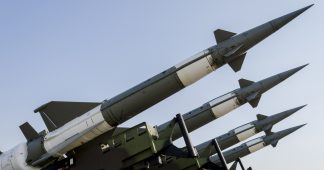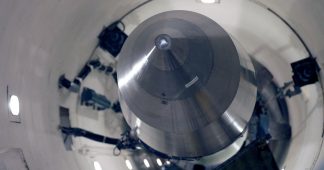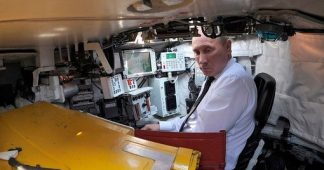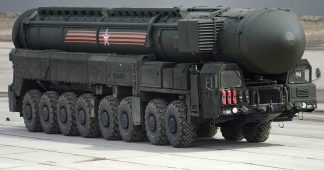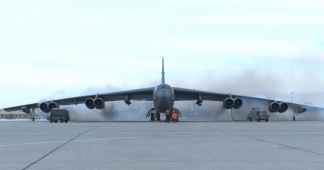By Alex Wellerstein
In the chaos that currently makes up the day-to-day of American foreign policy—a trade war here, tearing up international agreements and treaties there—it can be easy to miss the larger developments.
One of these, which occasionally rears its head in a frightened headline, is that there is a new nuclear arms race well under way.
In the United States, we typically get this in the form of news about the capabilities of other countries: Russia is developing a “doomsday torpedo,” China is developed “hypersonic missiles,” and so on. Whether these specifics are real or hype (experts are divided about the reality of the “doomsday torpedo”), they are part of a broader reality:
We’re back in an arms race. But it’s not a new one.
Developments in the technologies of nuclear weapons, their delivery, and their defense are rapidly changing. The popular perception of global nuclear development is that after the fall of the Soviet Union and the end of the Cold War, the nuclear arms race between the superpowers ended. And to be sure, there were a few years there in which the US and the Russian Federation worked together to get rid of redundant and unnecessary weapons systems and pare down their arsenals.
But those numbers not only weren’t going down to zero, they also concealed a grimmer reality: the nuclear arms complexes were never really dismantled, and the broader military-industrial complexes in both nations readily adapted to the new situation.
By the measures of some analysts, the “lethality” of the US nuclear arsenal—defined as the probability of the weapons to destroy “hard to kill” targets like bunkers and silos—actually peaked in the early 2000s, after the Cold War, and is still higher than it ever was in the 1980s. This is a counterintuitive concept for people who are used to the narrative of nuclear decline since the end of the Cold War.
The US still insists that nuclear deterrence is the bedrock of its defense strategy, even as it has steadfastly refused to declare that is the only use for its nuclear weapons. Despite most Americans being in favor of a purely retaliatory nuclear policy, official US policy leaves open the possibility of a first strike.
There is a large disconnect between what Americans think our nuclear policies ought to be, and what they currently are. The jittery bumps of the recent years—North Korean missile tests, the Hawaii false missile alert, the tearing up of the Intermediate-Range Nuclear Forces Treaty—are all just reminders that the specter of nuclear war, so long ignored, is still with us.
“Peace is our profession…”
In informal, off-the-record discussions I have had with members of the US defense community in the last year, an overarching sensibility is evident: Nuclear is back, baby.
The past three presidents (Clinton, Bush, and Obama) considered US reliance on nuclear deterrence to be a minor part of its overall international outlook. The Clinton administration definitely de-emphasized them; George W. Bush managed to cut the US nuclear warhead arsenal by half; and one of Barack Obama’s first speeches as president was about the importance of eliminating nuclear weapons.
But all three of these presidents kept the nuclear system alive, even if it wasn’t predominant. Under Trump, plans long in motion to upgrade and maintain the arsenal have morphed into a new grab for new hardware, new capabilities, and a return of lost prestige.
And a drive to spend, spend, spend.
The US Strategic Command, which was created in the post-Cold War period to manage US nuclear strike capabilities, has even brought back the Orwellian motto of its predecessor, the Strategic Air Command: “Peace is our Profession…” The ellipses were the only update made, deliberately meant to hint at the disastrous consequences of that peace failing.
But there’s nothing particularly peaceful about the US’s new gadgets. They include “super-fuzes,” which are improvements to existing weapons that dramatically increase their accuracy. The logic goes that the more accuracy you have, the fewer weapons you have to aim at any given target, which lets you do more with less. The Trump administration is also seeking to deploy low-yield warheads on its Trident missiles to make our nuclear threat seem less like a bluff.
But making the weapons “easier” to use might in fact encourage their use; there is no such thing as a “small” nuclear weapon in the eyes of our enemies. Every time the US pursues a program that could negate the existing offensive capabilities of other nations, they in turn are pushed to develop new offensive capabilities.
It’s a vicious cycle, and not a new one. What’s new is that we seem to be pursuing it deliberately, again.
Defense, offense, defense, repeat
Much of this has been driven by the US’s emphasis on developing ballistic missile defense, which goes back well into the Cold War. Missile defense is simple in concept: If someone shoots a missile at you, you shoot that missile down with another missile. But in practice, it is technically difficult: Missiles move fast, and offense is often cheaper than defense.
Regardless, the hope that one could somehow find a technological escape to nuclear vulnerability has had official support for a long time. The Ronald Regan-era Strategic Defense Initiative—or “Star Wars,” as it was derisively called—never really died. It changed names (and funding priority) over the years, and has survived in every postwar presidential administration. Now it’s blandly called the Missile Defense Agency.
The boring name belies its importance as a driver of international tensions. Initially, politicians argued that it was only going to be aimed at “rogue states,” which would arguably keep it more affordable and make it less threatening to other nuclear powers. But the most recent Missile Defense Review, released in January, now says it is also will target “revisionist powers,” a term that the Trump defense department uses to designate Russia and China. These states haven’t taken this lying down: They’re actively developing countermeasures.
Experts generally dismiss the effectiveness of ballistic missile defense. Its accuracy is not so great or reliable (contrary to a lot of public and apparently elected opinion), and in any event, the inevitable response by our enemies won’t be to admit defeat, but to develop technologies that subvert our defenses. This is why many experts consider missile defense destabilizing: It doesn’t get you defense—it gets you a new arms race.
How do you therefore defend against defense?
The “doomsday drone torpedo,” the “nuclear-powered cruise missile,” and the “hypersonic glide missiles” are all technologies that can deliver nuclear weapons to targets despite ballistic missile defense. These are the expensive, high-tech propositions to defeat these kinds of defenses—but it’s not clear all of them will work. The drone torpedo and the nuclear-powered cruise missile, in any event, appear to be old Soviet-era projects that have been resurrected by Russia, and are probably decades away from deployment. But the fact they’ve been given high-profile attention by Vladimir Putin is clearly a way to signal to both his domestic and international audiences that Russia won’t let its nuclear sword be blunted.
The US military is well-aware of these foreign developments and is somewhat giddy at the prospect of funding its own projects to “keep up” with them, even though they’re the cause for race in the first place. But it’s not just about legit defense: The tit-for-tat nature of this kind of technological development means new toys, more tax-payer money, and—importantly—more prestige.
A road to… where?
Where does this path lead? If history is a guide: nowhere good.
The best-case scenario is that we get out of this era without any nukes going off, having spent our money and resources on weapons that forever sat in silos. That’s money we won’t be able to spend on improving the social safety net, on improving medical care, on basic scientific and medical research, on energy security, on infrastructure upgrades, or on mitigating climate change.
That also means spending trillions on new systems that will likely leave the balance of power exactly where it started, if not creating new possibilities for things to go out of control. We’ll alienate allies who, if we’re lucky, will be so afraid of mutual adversaries that they’ll continue to play along. If we’re unlucky, they’ll start taking a harder line on our own disarmament responsibilities under the Nuclear Non-Proliferation Treaty, possibly undermining that regime.
So where should we go next? The answer to this will depend on your ultimate view of nuclear weapons, and what kind of safety they bring us. If you’re a hawk, your range of emotions range from enthusiasm for these new “opportunities,” or that they are “unfortunate but necessary.” If you’re a complete dove, you go to the same old answer as before: ban the bomb. Or, if you’re a more moderate dove, you hope that future treaties and negotiations will tamp down the worst possibilities and, maybe, in the very long term, lead to a more stable world. (The hawks currently rule the roost, and may for some time now.)
Are we in a new arms race? We’re in an arms race, all right. But it’s because we never really stopped the one that’s been going on since 1945. We’ve never woken up from that bad dream.
Published at https://qz.com/1680411/us-and-russia-are-starting-another-nuclear-war/
